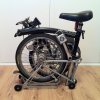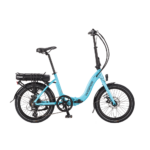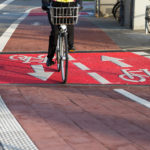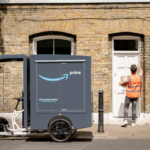I sold my car about 6 months ago and bought a Brompton fitted with an electric conversion. I thought I'd share how I have been getting on.
As a couple we had 2 cars but one of them wasn't getting much use after my wife changed jobs and was commuting by train. For the last few years the majority of my work has been as a mobile therapist travelling by car. I got fed up of being stuck in traffic during rush-hour, subsequently running late for appointments and plus I was spending an average of 3 hours a day travelling. I was looking for an alternative. I live close to a train station and have started working in central London so a folding bike made some sense. With my work equipment totalling 16 to 18 kg and my refusal to turn up to work positively sweaty Betty meant that I started to look into the possibility of an electric assist.
I was pleasantly surprised to find that battery technology has come a long way in the last few years offering a relatively lightweight and reliable option. An electric assist does however bump the price up considerably and so security was a main factor in my decision. I was initially, looking for an assist that could be detached and taken with me when the bike was locked up somewhere. A friction drive device looked like possibility until I found out that they seem to make a considerable noise and are less efficient in poor weather (of which we suffer plenty).

I decided on a Brompton M3R model (black) that allows room on a rear rack for my work equipment with the option for a detachable front bag to perform as a day (man) bag. I found a second-hand bike that had already been converted from The Electric Transport Shop (TETS) in Cambridge. I had to wait a couple weeks whilst the guys at the shop tested it and did some servicing. In the end it was determined that the existing battery and motor were not serviceable and therefore were replaced before the bike was handed over to me.
I had a few false starts. On returning from Cambridge I discovered the charger was faulty and to the shops credit I was sent an immediate replacement whilst I returned mine. My 1st ride on an ebike was the same, in my experience, as everyone else I have seen ride one, I couldn't stop grinning. After a few minutes my twitchy steering from the 1st time riding a bike with small 16 inch wheels seemed to calm down and it felt a comfortable and pleasurable ride. Unfortunately on my way home the brake block fouled the tyre wall and I had a blowout. After tracking down a local Brompton dealer to replace the tyre and inner tube I was up and running again. I started to use the bike to commute to work a distance of roughly 8 miles each way to begin with.
After about a month of using it I had a problem with the electric cable routing. The battery pack was mounted on the seat pillar and as the bike was unfolded the wire was being caught between the suspension block and the frame, this eventually led to the wire failing. I took the bike back to TETS in Cambridge as I had a year warranty on the electrical components. After a few days I had the bike back with the wiring mended. I decided I wanted to change the mounting of the battery to a front luggage bag so the wire could not get caught again (so to avoid any future wrath from the wife regarding an 11pm phone call requesting her aid as an emergency breakdown service). The seat pillar was slightly bent as well which affects the fold of the bike, I wasn't sure whether the battery and battery holder was a factor in this.
The challenge here was that the threads front mounting to hold the luggage block were (ironically) 'screwed'. On closer inspection it had already been re-threaded once and there was not enough metal left to do it again. It looks like a new frame is the only long term solution. A local bike shop tried to fix it but it didn't last long, now I have bodged a temporary solution using JB Weld and a putty weld to permanently fix the luggage block to the frame. So far it has held with a reasonable amount of weight taxing it but I think I'd better start budgeting for a new frame before too long. By now my funds were running low, I decided to save some money and cut down the Brompton bag frame and make my own bag to take the battery.

I also made a silnylon waterproof cover for the bag out of an old tarp to protect the electrickery against our beautiful British climate. I have yet to test the front bag and cover as I have had another problem with the electrics and the battery has stopped charging so that has been sent back to the Cambridge shop for repair.

The sewing machine was out, I had some silnylon material left and Netflix was on in the background keeping me occupied so I decided to save some more money and make a waterproof cover for the Brompton as well. I've tried a couple different silicone seam sealants but both have started to come off so I need to go back to the drawing board with that one.



One of the things on my "to do" list is to sort out my gear ratios. I currently have the 50T standard chainring and a 13T rear sprocket with a Sturmey Archer 3-speed hub giving me 75%, 100% and 133% ratios. If my calculations are correct this gives me gear inches of 47.7, 63.7, and 84.7 to work with. Although my rides are predominately flat I do struggle with some hilly parts of West Essex I have to visit regularly and would like to trade the top gear for a lower number. I'm not yet sure how I am going to do this. My options are to change to a 44T chainring, change the rear sprocket or change to a Brompton Wide Range Hub. Ideally I would love the weight of a 2 speed set up with just one gear for flat and one gear for hills but can't see how I can get a wide enough range with just two gears. It doesn't help that I don't have much experience of riding bikes and I can see myself changing my set up several times until I find out what works best.
This leads me onto my main challenge so far with the bike. The amount of pedalling resistance (can I use the term rolling resistance here?) when the electric assist isn't on. With the assist the bike is an absolute joy to ride but without it, it's like riding through thick mud. I can pedal in first gear on the flat, preferably with a tailwind. But even that isn't really comfortable for me. This means that when I have had an electrical failure I have had to abandon my journey, that isn't what I thought would happen. This combined with the lack of an accurate battery gauge has left me with little confidence using the ebike over longer mileage and so have frustratingly temporarily moved back to using (what's really the wife's) car for work. I need to be confident with my set up for work. So this is the next challenge. Is this high resistance normal? Does the motor need servicing? Do I need to invest in another motor maybe one less powerful motor but has less resistance? I don't know yet but will endeavor to find out what's going on.
So mini conclusion so far? Basically I'm sold! I have discovered the joy of cycling and very much prefer it over car commuting. I love the Brompton particularly that it opens up so many possibilities for me with multi-modal transport and I love the concept of an electric assist. I just haven't made it work for me YET. I am determined to do so and will post updates as I go along!
Can I ask for some advice from the forum please about the resistance to pedaling without the assist? Is this normal? Is there a way that I can measure it?
Thanks in advance.
James
As a couple we had 2 cars but one of them wasn't getting much use after my wife changed jobs and was commuting by train. For the last few years the majority of my work has been as a mobile therapist travelling by car. I got fed up of being stuck in traffic during rush-hour, subsequently running late for appointments and plus I was spending an average of 3 hours a day travelling. I was looking for an alternative. I live close to a train station and have started working in central London so a folding bike made some sense. With my work equipment totalling 16 to 18 kg and my refusal to turn up to work positively sweaty Betty meant that I started to look into the possibility of an electric assist.
I was pleasantly surprised to find that battery technology has come a long way in the last few years offering a relatively lightweight and reliable option. An electric assist does however bump the price up considerably and so security was a main factor in my decision. I was initially, looking for an assist that could be detached and taken with me when the bike was locked up somewhere. A friction drive device looked like possibility until I found out that they seem to make a considerable noise and are less efficient in poor weather (of which we suffer plenty).

I decided on a Brompton M3R model (black) that allows room on a rear rack for my work equipment with the option for a detachable front bag to perform as a day (man) bag. I found a second-hand bike that had already been converted from The Electric Transport Shop (TETS) in Cambridge. I had to wait a couple weeks whilst the guys at the shop tested it and did some servicing. In the end it was determined that the existing battery and motor were not serviceable and therefore were replaced before the bike was handed over to me.
I had a few false starts. On returning from Cambridge I discovered the charger was faulty and to the shops credit I was sent an immediate replacement whilst I returned mine. My 1st ride on an ebike was the same, in my experience, as everyone else I have seen ride one, I couldn't stop grinning. After a few minutes my twitchy steering from the 1st time riding a bike with small 16 inch wheels seemed to calm down and it felt a comfortable and pleasurable ride. Unfortunately on my way home the brake block fouled the tyre wall and I had a blowout. After tracking down a local Brompton dealer to replace the tyre and inner tube I was up and running again. I started to use the bike to commute to work a distance of roughly 8 miles each way to begin with.
After about a month of using it I had a problem with the electric cable routing. The battery pack was mounted on the seat pillar and as the bike was unfolded the wire was being caught between the suspension block and the frame, this eventually led to the wire failing. I took the bike back to TETS in Cambridge as I had a year warranty on the electrical components. After a few days I had the bike back with the wiring mended. I decided I wanted to change the mounting of the battery to a front luggage bag so the wire could not get caught again (so to avoid any future wrath from the wife regarding an 11pm phone call requesting her aid as an emergency breakdown service). The seat pillar was slightly bent as well which affects the fold of the bike, I wasn't sure whether the battery and battery holder was a factor in this.
The challenge here was that the threads front mounting to hold the luggage block were (ironically) 'screwed'. On closer inspection it had already been re-threaded once and there was not enough metal left to do it again. It looks like a new frame is the only long term solution. A local bike shop tried to fix it but it didn't last long, now I have bodged a temporary solution using JB Weld and a putty weld to permanently fix the luggage block to the frame. So far it has held with a reasonable amount of weight taxing it but I think I'd better start budgeting for a new frame before too long. By now my funds were running low, I decided to save some money and cut down the Brompton bag frame and make my own bag to take the battery.

I also made a silnylon waterproof cover for the bag out of an old tarp to protect the electrickery against our beautiful British climate. I have yet to test the front bag and cover as I have had another problem with the electrics and the battery has stopped charging so that has been sent back to the Cambridge shop for repair.

The sewing machine was out, I had some silnylon material left and Netflix was on in the background keeping me occupied so I decided to save some more money and make a waterproof cover for the Brompton as well. I've tried a couple different silicone seam sealants but both have started to come off so I need to go back to the drawing board with that one.



One of the things on my "to do" list is to sort out my gear ratios. I currently have the 50T standard chainring and a 13T rear sprocket with a Sturmey Archer 3-speed hub giving me 75%, 100% and 133% ratios. If my calculations are correct this gives me gear inches of 47.7, 63.7, and 84.7 to work with. Although my rides are predominately flat I do struggle with some hilly parts of West Essex I have to visit regularly and would like to trade the top gear for a lower number. I'm not yet sure how I am going to do this. My options are to change to a 44T chainring, change the rear sprocket or change to a Brompton Wide Range Hub. Ideally I would love the weight of a 2 speed set up with just one gear for flat and one gear for hills but can't see how I can get a wide enough range with just two gears. It doesn't help that I don't have much experience of riding bikes and I can see myself changing my set up several times until I find out what works best.
This leads me onto my main challenge so far with the bike. The amount of pedalling resistance (can I use the term rolling resistance here?) when the electric assist isn't on. With the assist the bike is an absolute joy to ride but without it, it's like riding through thick mud. I can pedal in first gear on the flat, preferably with a tailwind. But even that isn't really comfortable for me. This means that when I have had an electrical failure I have had to abandon my journey, that isn't what I thought would happen. This combined with the lack of an accurate battery gauge has left me with little confidence using the ebike over longer mileage and so have frustratingly temporarily moved back to using (what's really the wife's) car for work. I need to be confident with my set up for work. So this is the next challenge. Is this high resistance normal? Does the motor need servicing? Do I need to invest in another motor maybe one less powerful motor but has less resistance? I don't know yet but will endeavor to find out what's going on.
So mini conclusion so far? Basically I'm sold! I have discovered the joy of cycling and very much prefer it over car commuting. I love the Brompton particularly that it opens up so many possibilities for me with multi-modal transport and I love the concept of an electric assist. I just haven't made it work for me YET. I am determined to do so and will post updates as I go along!
Can I ask for some advice from the forum please about the resistance to pedaling without the assist? Is this normal? Is there a way that I can measure it?
Thanks in advance.
James








